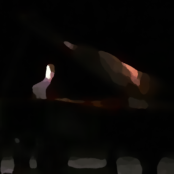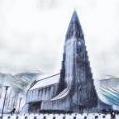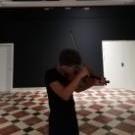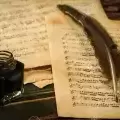-
Posts
200 -
Joined
-
Last visited
-
Days Won
20
Jared Steven Destro last won the day on June 4 2022
Jared Steven Destro had the most liked content!
About Jared Steven Destro
- Birthday 08/19/1998
Contact Methods
-
Website URL
jdestro.com
Profile Information
-
Gender
Male
-
Favorite Composers
Carl Nielsen, Frederick Delius, Sergei Prokofiev, Dmitri Shostakovich
-
Notation Software/Sequencers
Dorico
-
Instruments Played
Piano
Recent Profile Visitors
4,778 profile views
Jared Steven Destro's Achievements
-
Claudio Camacho started following Jared Steven Destro
-
Thank you for taking the time to comment on this. I used to work in this way more frequently -- taking a melody and using it as a compositional basis. For instance, I composed an orchestral piece a traditional Polish melody (link); used a medley of melodies (this is one of Chopin's) whilst improvising at the piano (link); used ancient Greek melodies (link); and I use my own pieces as a basis all the time (link) etc. Each was with different methodologies with a variance of flexibility. The Polish melody one for instance was originally much simpler (spontaneous), but the orchestration grew more ordered and complex as it was revised, controlling its usage to a planned structure; the improvised set was completely spontaneous; and the last one was planned merely to utilize the melody. In any of the examples though, I felt it was more important my manipulation of the material as opposed to being accurate to the original -- capturing the spirit through recomposition and by taking ownership and controlling the material in as personal a way as possible. It is definitely a fun way to compose, especially the more thorough and inquisitive the approach. Having some form of order to control when and how material is introduced is certainly helpful. I learned this when composing a work for brass quintet, when one work of mine used 16 quotations of various people and the form was hard to bind together in a convincing enough manner, in my opinion. I doubt I would return to this piece (it was back when I was still using a "opus" based catalogue, and it was written when I was a different person). But, it was a fundamental style of composition that helped push me into other areas. This piece was composed in one sitting and without much thought aside from what was spontaneous, which is a consequence of my improvising background. Just writing in that manner has its benefits, but is by no means free from drawbacks. Thanks again for commenting, and I am contending posting more music at one point though I am trying not to overdo it to be honest. I, like many, write a considerable amount of music, often times for no reason at all, which is not particularly wise when you are someone that is, like me, prone to mental health issues. But it would be nice to have for you more relevant examples of my writing, if only to share them with someone other than myself.
-
Thank you for your comment. It is true that in the orchestration of this piece -- one that was composed when orchestration was new to me and I was starting high school -- descends into many pitfalls. The trumpets, for instance, are particularly confused (as much of the repertoire I listened to at the time was for natural trumpets, which are of course different than the modern instrument). This, amongst many reasons, is why this piece has in my catalogue been destroyed. I am aware the capabilities, broadly speaking, of a human being playing an instrument. I am also aware that music, in this context at least, is for human players, and that some humans are better at some things than others (taking into account things like circular breathing or the heat of the mouthpiece for a brass instrument). But more importantly, understanding the scale of difficulty -- what actually is possible, what is hard, what is easy -- was a long path, and I got there through diligent experimentation. This work was still quite early into that trek, and so it certainly fails in many of the ways you point out. Since I was in no position to be around musicians or orchestras at the time, this piece was never meant to be performed, and it was an experimentation into form and texture on a large scale (compared to what I had worked on previously). Things I have noticed that are more striking is the exclusion of many important notational devices, such as dynamics for some of the instruments. When I return to these abandoned pieces, it is about a balance of extracting the broader image of the piece with the smaller details, such as an obviously preposterous trumpet line. You can rest assured that I take under consideration much of what you have criticized in more modern pieces of mine, and there is no longer any attunement necessary.
-
Jared Steven Destro changed their profile photo
-
Thank you @Syrel for your in-depth feedback on my piece. To tell the truth, I cannot even remember what VST/library I used at the time this was created. It's certainly not as bad as it gets, though I've since learned there are far more impressive sounds one can access. Moreover, the score was produced in Finale--a program I cannot recommend whatsoever, nor do I like in any regard Sibelius. Luckily, I have improved the sounds of my many mock-up works, and I primarily use the Spitfire BBC yadyadayada whatever it's called. With that said, I know there is a level of optimization that can be placed thereafter, though I have found being very specific with articulation and dynamic markings has produced an acceptable result. To be honest, technology in general has never been a strength of mine, and I am just happy that I use Dorico and that I am now very comfortable with it. I create paintings/digital art--not that they are spectacular--to accompany my engravings as an added security measure, and that is about the level of my computational finesse. Thank you again for your comment--it is appreciated.
-

Piano Trio No. 1, "Conference of the Birds"
Jared Steven Destro replied to Jared Steven Destro's topic in Chamber Music
Thank you @Syrel for your comment. From the time I have had working with others, it goes a long way ensuring each part is catered for both the instrument and the player; and while this piece was not composed for anyone in particular, I knew that both form and philosophical material were the most important things when crafting this work, so I very much considered what you have pointed out. Thank you again for your kind words. -

Piano Trio No. 1, "Conference of the Birds"
Jared Steven Destro replied to Jared Steven Destro's topic in Chamber Music
Thank you @Left Unexplained for taking the time to listen and comment on my piece! -
Jared Steven Destro started following Nocturne , Piano Trio No. 1, "Conference of the Birds" and Erlkönig (Rev. 1)
-
Hello everyone. I used to post quite frequently, though not really anymore, in part because of my mental health. Despite this, I wanted to share at least one piece of mine that is mildly recent. I try not to share my music aside from my website(/soundcloud), but I have written quite a bit regardless, and this is a work that I feel comfortable sharing (although it has not been performed, so the recording is a mock-up). Some have asked about my style, which is no longer as it was in some of my earlier works on this website, so this work can clarify some of this for those who are interested. The piece is in one movement, and it is for viola, violoncello, and piano. It is primarily centered around the Sufistic text "Conference of the Birds" and it uses a variety of methods that I return to in other works. It is not the most complex work in my catalogue, but it is one that means a great deal to me. AUDIO (with more info on the piece as well) https://jdestro.com/trios#piano-trio-no-1
-
Thank you for your comment. This work is part of an earlier catalogue of mine -- one that consists of several hundred juvenilia; and, as such, it reflects the period of development that I was in -- one of exploration in different areas, such as texture/inspiration/form/reference/etc. In essence, I had not yet settled on the key characteristics that would come to define my music in later projects, and during this period the main composer whose music I studied with great detail is Joachim Raff, who remains the only person in the Romantic period to whom I routinely listen. This work serves as a good junction at which my music began to take shape, though it by no means reflects what I produce now. Thank you kindly for your feedback on this work -- I would not say that it is a clear representation of where I stand at this point, however, and thus stylistic concerns with this piece are, in particular, of limited impact. Instead, what I see in this work is a tendency toward pedal tones (which is a result of my improvisational practice at the piano, and something I continued to improve upon with the works of J.C. Bach at the time); an attempt at a cohesive, encompassing form -- one that varies in narrative perspective and in textural content; and a simplistic, earnest processing of orchestral color. This piece was an important step in the right direction for me, though it is a step behind me, not one in front of me.
-

Scherzo in F minor, for Violoncello & Piano
Jared Steven Destro replied to Jared Steven Destro's topic in Chamber Music
@PeterthePapercomPoser Thank you for taking the time to comment on this work, though I must admit I have not thought about this piece in years. It was, like hundreds of other works of mine, either destroyed, abandoned, or repurposed. Even my modern catalogue started in 2019 of around 100 has a dozen or so of the same fate. I'm happy to say that many of those expectations you confronted in this piece have been better handled in newer works, though it has been a while since last I posted any music. In recent years, I've tried my best to avoid sharing my music, especially with scores included. But thank you again for commenting, if only for a piece that no longer exists. -
That's really interesting! The period of time that comes to mind for me would be the transition between the Baroque and Enlightenment, with someone like C.P.E Bach. I find the form of some of his symphonies and concertos to be very dramatic and I think that it relates to the idea of varying material and developing a musical story. I feel that when you go in and start to consciously vary your material section to section it's a good habit to get into!
-
I enjoyed your piece! I especially liked the change of texture at b. 17. It is a relatively short piece, that in my mind feels complete, though I wonder if you could expand on a few sections (maybe the section on the second page?). As with some of your other pieces, I think you chose some interesting intervals throughout, and they definitely bring strength to your choice of harmony. I might consider looking for places to provide space in the music, especially for the violin. Even it is a crotchet's worth, it'll break the music up so that it doesn't feel too constant or even rushed (something like the move from b. 20 to b. 21 is effective, and I think it could benefit earlier in the piece!). In terms of engraving, I think you've done a pretty good job! I would suggest that you only include dynamics for both hands of the piano if they differ, which they don't seem to do here (though this is to do with the music software maybe?). I also think it might be useful for the violinist if they had some phrase markings/slurs that they would use to determine the emotional character and their bowing. I would consider doing away with the abbreviated staff names as well! When it is only piano + instrument, it isn't wholly necessary. For this combination, the "solo" instrument (violin here) would have a staff at 75% the size of the piano (if this is something possible in your software).This will impact the margins of the music in a positive way (in fact, I would increase the margin size left and right, top and bottom by a good deal). As a bonus, this would make it more clear to you that moving b. 27 onto page 3 (which I think would make sense). These are some thoughts, and I hope you find them useful. Overall, I enjoyed your piece!
-
I think this is a great place from which to start! The character of the piece is very cheery and the harmonic language, in my mind, follows closely with traditional harmony. In general, I felt that it was a complete, short piece! I think that one thing you could consider would be rewriting the repeated sections and trying to vary them! This could mean introducing more contrasting rhythms or experimenting with different harmonies. The goal of doing this would be to move out of your comfort zone a bit, and to do so in a relatively strict form (of an AABB, for example). As more of a sidenote, I am not sure what program you are using (so it is probably at fault, and so I wouldn't recommend getting into a brawl with it) but some of the engraving of the piece is very strange. I felt it might be useful to point out a few things, just in case you aren't sure yourself! For example, in bb. 1-2, you have two voices in the RH and I would probably add rests to show when voice 2 starts and ends; this also would clear up some confusing with stems pointing in different directions, like in b. 2. Even if the music isn't using a load of complex rhythms, it is a good practice to get into! Also, slurs follow some strange rules in this program, with the second group of quavers in b. 3 having the slur upside down. Even some noteheads are reversed as in bb. 10-11. (LH). Clef changes are a bit strange, as you wouldn't reiterate the key signature in an instance at b. 14. And, with b. 17, you would have a cautionary clef at the end of b. 16 with the bass clef being where the treble clef is at b. 17. Again, I imagine you might have limited control over this, but it is all worth mentioning (I noticed the names of the instruments above each staff, which isn't necessary, but I assume the program disallows it from being any other way). With the name change, I am not sure why it changed to "in D", but overall I think you did a nice job. My suggestion is to keep writing, and perhaps make some adjustments to this piece. Best of luck!
-

Op4 Nr7 Conflict and Chaos
Jared Steven Destro replied to cloud10000's topic in Piano Music, Solo Keyboard
Very interesting piece! I think the perpetual motion is handled well, and you are able to generate a good deal of variety in what is predominantly a texture of constant quavers. Graphically speaking, I personally feel the background used in the score is distracting and makes the score more difficult to read (I'm also not sure if I'd want to print the document in color, were I to learn it). For the purpose of a video, I think it's a unique personal touch; I would avoid doing it on the actual score, however! I also wonder how effective it is to shift the barlines visually, as you have done. I think that I understand the intent, but it makes it significantly less clear for a performer and I am not convinced it's necessary. At the most, I would consider polymetrical beaming across the barline. Overall, though, I really enjoyed your piece - it feel like a complete work and it kept my interest. I hope some of my comments help. Great job!- 2 replies
-
- polytonality
- virtuoso minimalism
- (and 5 more)
-
I think that you're getting in the right mindset with some of the changes you made, so good job! I think that you have the right heart with an addition of phrase marks starting in b. 42 - I wouldn't notate it in this way, however. With something like this, I would consider: what the piano could potentially be pedaling (something you could add, but wouldn't be necessary); when new phrases begin and end; and the character of the music. If you want more of a legato effect, I would simply add it in this case (leaving out the very long phrase marks). It can be more difficult in hindsight, so I'd suggest you carry that with you into the future! In a similar manner, adding different articulations - like in b. 54 - can potentially be difficult to gauge working retrospectively. It's a shame that your program is having difficulty inputting dynamics! I suppose, it's important to contemplate the dynamic balance of the piece - it could certainly be as important as pitch/harmony/rhythmic. These are just a few thoughts, and I hope you find some of them useful!
-
I enjoyed the meandering, flowing character of this piece. You've gone for some interesting intervals and modulations, as on the second page which I enjoyed. The contrasting middle section was also a good way to break up the texture in the piece, as well! As it relates to engraving, I am not sure what program you're using (so I don't know if it's difficult to make certain changes) - but I might consider including a brace, which would be a more familiar sight for piano music. Shifting your margins toward the left a bit more (so that they are more evenly spaced, though with enough of a buffer for potential page turns) would also be a consideration. Another suggestion might be to space out some of the systems (like bb. 41-45, 46-50). That would add to the visual comfort and clarity of the score! I think in general you've been clear throughout with what you've written; a situation like in bb. 64-65, I would say that you could do with just one hairpin. Overall, I think you did a great job!
-

Rose Windows, for piano
Jared Steven Destro replied to Jared Steven Destro's topic in Piano Music, Solo Keyboard
Thank you kindly - I appreciate you giving my music a listen. You never know how these different approaches might end up, but I had fun doing it, and it's nice to break up the approach now and again!








.thumb.png.8b5b433a341551e913a34392660bc95b.png)


